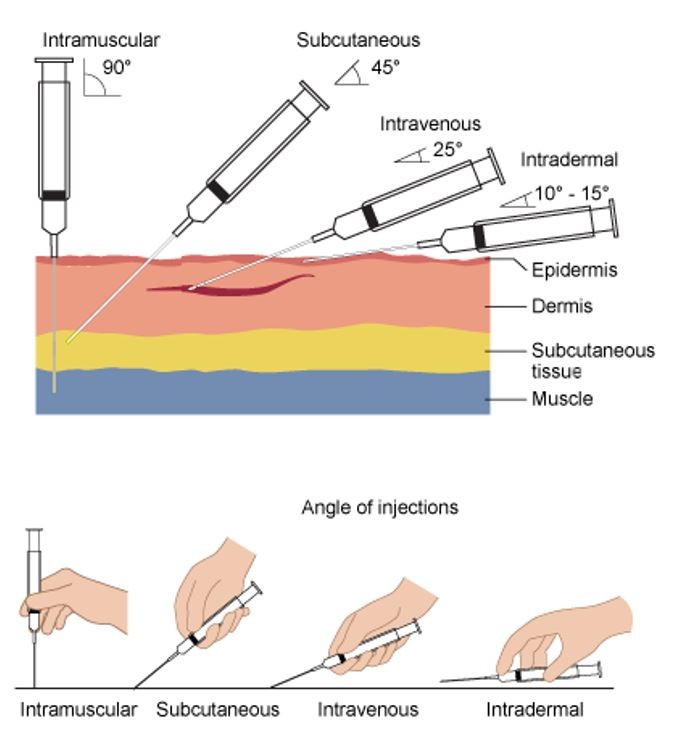How you Administer Injections Matters
Amy Barkley, Livestock Specialist
Southwest New York Dairy, Livestock and Field Crops Program
Injections are necessary, and sometimes even life-saving, for many of our livestock species. Each liquid that we inject is formulated to be placed not only in different regions of the body (think the triangular mass of muscle of the neck for most cattle vaccines vs the buttocks for some equine injections), but also in different layers of tissue (muscle vs skin vs vein). The correct placement of a needle allows the vaccine, fluid, or antibiotic to fall in the proper place to be absorbed by the body in the most effective manner. Angles of the four most common injections are listed below from largest (perpendicular with the skin surface) to smallest (nearly parallel with the skin surface).
Intramuscular: This injection is made to go deep into the muscle. The needle will be placed at a 90-degree angle (perpendicular) to the skin to allow for penetration into that tissue. A large muscle works best for these injections, but care needs to be taken with placement, especially on meat animals, since many of these injections cause damage, and ultimately condemnation, of the muscle tissue they come in contact with.
Subcutaneous: A properly placed subcutaneous injection is going to result in a lump of fluid underneath the two layers of skin (epidermis and dermis). The depth of these two layers varies with species, breed, and age. Under the skin layers resides connective tissues, which lack blood vessels, resulting in a slow absorption of any liquid placed there. An area of loose skin is an ideal place for these injections since there is room for the fluid to accumulate. The needle will be placed at an angle of 45 degrees to the skin surface.
Intravenous: The needles used for either injections or removal of blood should be placed where a vein is readily accessible. This is usually in the legs, neck, udder, or tailhead of our livestock species. Many times, the veins are readily visible, but sometimes moderate pressure needs to be applied below the area where blood is being removed to make the vein obvious. To access the vein, the needle should be inserted at an angle of 25 degrees to the skin. Drawing back on the plunger of a properly placed syringe should result in some blood in the syringe body, indicating the needle is in the vein.
Intradermal: This injection requires the needle to be placed just under the epidermis (outer layer of skin) and into the dermis (inner layer of skin). These injections take a very fine needle (larger gauge, shorter length). Correct placement of the needle is between 10 and 15 degrees with the skin surface. Correct placement is verified by the formation of a blister of fluid just under a thin layer of skin.
 Photo from Wikipedia
Photo from WikipediaUpcoming Events
WNY Pastureland Conversion & Soil Health Field Day
July 16, 2025
Middleport, NY
Join American Farmland Trust for the Western New York Soil Health Field Day on July 16, 2025, at Zeliff Farm in Middleport, NY, from 9:00 AM-3:15 PM. Learn about pasture conversion, soil health benchmarking, biochar in grazing systems, and best grazing practices. Plus, enjoy hands-on demos with the NY Soil Health Trailer, drones, and cover crops! Check out the attached agenda for more information about the field day and REGISTER HERE. Zeliff Farms is a regenerative beef operation who has recently partnered with AFT on outreach and education to farmers including learning circles and evaluating biochar effects on soil health.
IPM Strategies to Protect Corn and Soybean Seed in NY
July 30, 2025
Hamburg , NY
SWNYDLFC and Cornell IPM are hosting a grower meeting to discuss integrated pest management strategies for protecting corn and soybean seed in New York.
FAMACHA Training for Sheep and Goat producers in Woodhull NY
August 13, 2025 : FAMACHA Training in Woodhull
Woodhull, NY
Join us for a discussion and hands-on training for internal parasite integrated pest management in sheep and goats. Certification is available to all students participating in the workshop.
Announcements
No announcements at this time.





